Organic gardeners know that when ladybugs are abundant in the springtime, they can anticipate a bountiful harvest.
Fortunate is the homestead blessed with an abundance of ladybugs. Ladybugs are guests you want to invite and keep in your garden. Read on to learn a bit about these beneficial insects, how to properly identify them, and how to select plants to add to your homestead landscape that will entice these good guys to join the garden party.
Go Organic
If you want to attract ladybugs to your homestead, you first have to practice organic methods of gardening and farming. Ladybugs will never stay around a homestead treated with noxious chemical herbicides and pesticides.
Ladybugs are attracted to fragrant flowers. If you want them to make your garden their home, you must first establish beds of highly scented annuals and perennials.
Ladybugs are efficient. An effective natural pest control, ladybugs consume up to 50 aphids a day per ladybug. To encourage ladybugs to visit and stay in your garden, it is necessary to provide them with groundcover, water, and colorful, fragrant plants that entice.
Marigolds are one of the best plants to draw in ladybugs. Marigolds also repel other unwanted garden plant predators.
Plant Scents That Attract Ladybugs
- Cilantro
- Calendula
- Dill
- Parsley
- Buckwheat
- Mint
- Oregano
- Tansy
- Thyme
- Rosemary
- Sweet basil
- Horehound
- Dandelions
- Garlic
- Fennel
How To Add Ladybugs To Your Garden
Ladybug larvae and adult ladybugs are available for purchase online. When they arrive, either release them directly into your ecosystem or use the purchased beetles as stock for raising an ongoing supply. Commercial kits for ladybug farms are available for purchase or you can make one following easy online instructional videos.
https://www.instagram.com/p/qvODwNEipn/?tagged=ladybugfarm
When releasing ladybugs into the garden to control an insect infestation, consider covering individual plants with a screened box after placing a few ladybugs on the plant. Allow them to get to work eating aphids, mites, whiteflies until the plant is rid of pests.
Then move them to another infested plant or return them to an artificial habitat. To control insects in a larger area, create a tunnel out of flexible plant stakes and cover with cheesecloth yardage, tucked under at the sides and end of the tunnel.
Ladybugs Are Harmless To Humans
Beginning gardeners often ask if ladybugs bite. Unlike most insects found in the home or garden, ladybugs are quite harmless. They do not sting, destroy plants or property, or transmit illness to humans or their pets. However, if provoked, they can and will bite.
They do have mandibles to enable them to chomp away at other soft-bodied bugs. Should you be bitten, the bite rarely causes more than a small discomfort, is unlikely to become infected, and the bite rarely causes an allergic reaction.
What To Do When Ladybugs Move Indoors
Homeowners are often bedeviled by a home infestation when ladybugs move indoors – seeking warmth and shelter for the winter. Ladybugs are especially drawn to light-colored homes with a southwestern exposure.
Yikes! They are everywhere. If you swat at them and spook them, they smell! Asian ladybugs are the worst offenders. The odor, which smells like rotting, moldy potatoes, is a warning signal to potential predators.
https://www.instagram.com/p/BMEI4bbDPFP/?tagged=ladybuginvasion
Remember it is very bad luck to kill a ladybug, and no one wants to offend Lady Luck. The most humane way to get rid of ladybugs that move indoors is to suck them up with a vacuum cleaner:
Cut the foot and legging portion out of a pair of old nylons. Slide the open end over the end of the vacuum hose, secure in place with a rubber band, and suck up the little critters. Once the ladybugs are sucked up inside the sock, remove the sock, twisting it tight, so the ladybugs don’t escape and take them outdoors to release or place in an artificial habitat.
All About Ladybugs
Ladybugs are typically red, orange, or yellow with a number of black spots on their wing covers. Their antennae, heads, and legs are black. The life cycle of the ladybug is similar to that of the butterfly: the egg stage, the infant larvae stage, the development pupa stage, and the mature adult ladybug stage.
Upon hatching, ladybug larvae immediately look for something tasty to eat, preferring tiny aphids and mites. After a few days, larvae begin to molt, continuing to molt for as long as they are growing. Baby larvae, under the microscope, look like little alligators.
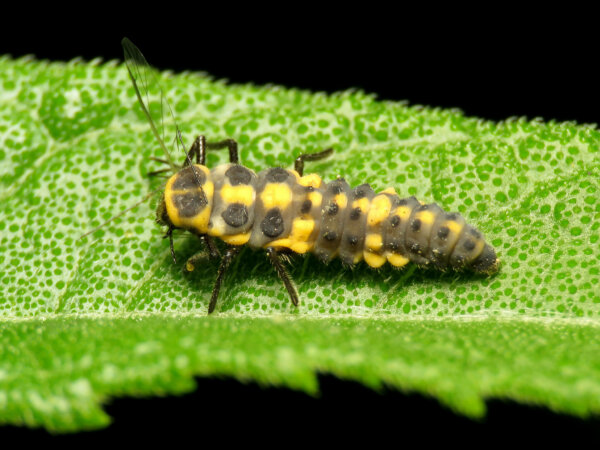
After growing for a week or two, larvae begin to change appearance, now looking like fat baby shrimp. During the pupa stage, the larvae attach themselves to the underside of a leaf, sleeping during the metamorphosis that changes the pupa into a ladybug.
A healthy, well-fed female ladybug lays more than 400 eggs in her lifetime. Commonly found types of ladybugs in North American gardens include the following:
Two-Spotted Ladybird Beetle
Native to Europe and North America, the two-spotted ladybird beetle exhibits red wings with two brown or black spots on a dome-shaped body. They hibernate when temperatures plummet, emerging in early spring to feed on soft-bodied insect pests.
https://www.instagram.com/p/BXiS6NXFNp2/?tagged=twospottedladybird
Convergent Ladybug
One of the most commonly known ladybugs in North America, the convergent lady beetle presents an elongated, dome-shaped body with a significant number of spots on their colorful red wings. Some convergent ladybugs can boast as many as a dozen or more spots. You can easily identify this ladybug by the prominent white/black pattern on their head.
https://www.instagram.com/p/BQtaT5ZgAhZ/?tagged=convergentladybugs
Asian Lady Beetles
Native to the Pacific Rim, multi-colored Asian lady beetles are a bit abnormal in that they may have numerous spots or none at all. Asian ladybugs can be identified by a distinctive “m” or “w” shaped marking on the top of their heads. If you have a problem with scales or aphids in the garden, these tiny insects can help quell an infestation of soft-bodied plant pests.
https://www.instagram.com/p/BbIkIJUB5HQ/?tagged=asianladybeetles
Twice-Stabbed Ladybugs
Twice-stabbed lady beetles are very tiny, little black ladybugs with red spots. Aggressive feeders, twice-stabbed ladybugs feast on a preferred diet of scales. As any gardener can tell you, scales are nasty, invasive pests. An infestation in trees or shrubs can be difficult to control.
If scales are evident around the homestead, twice-stabbed lady beetles are an effective solution available for purchase from home and garden centers, landscape nurseries, or online from insectaries.
https://www.instagram.com/p/BYaoc4ihsQW/?tagged=twicestabbedladybeetle
Mealy Bug Destroyer
A specialized feeder, the Mealybug Destroyer is an aggressive feeder with a penchant for mealybugs. Imported from Australia in 1891 as a warrior in the war on mealybugs, this little guy displays a bright orange head and dark brown body. If mealybugs infest your garden, the Mealybug Destroyer ladybug is an excellent solution in lieu of employing toxic pesticides.
https://www.instagram.com/p/BUxrCffAsio/?tagged=mealybugdestroyer
Spider Mite Destroyer
A tiny black ladybug, known as the spider mite destroyer, is the smallest of ladybugs, yet one with a humongous hunger. Spider mite destroyer ladybugs primarily feed on spider mites, consuming as many as a 100 mites per ladybug.
https://www.instagram.com/p/BY_ksHcHDUJ/?tagged=spidermitedestroyer
Pink Spotted Ladybugs
Also native to North America, pink spot ladybugs are found throughout Canada, along the United States’ eastern seaboard and as far west as Nebraska. Pink, with a spotted, oval-shaped domed body, pink spot ladybugs especially love flowers. If you want to attract these delightful plant-eating pest eaters, plant chamomile, violets, lavender, or geraniums.
https://www.instagram.com/p/BIlY21xDaT3/?tagged=pinkspottedladybug
Seven-Spotted Ladybugs
Native to Europe and released in North America as a biological pest control agent imported to feed on aphids, seven-spotted ladybird beetles are one of the larger types of ladybugs. With voracious hunger, they gobble up aphids and mites. Seven-spotted ladybugs boast an odd number of spots, with one spot split between each wing.
https://www.instagram.com/p/BM5OaSChyxI/?tagged=sevenspottedladybug
Ladybugs Have History
Ladybugs symbolize protection, love, joy, and prosperity. Ladybugs, also known as ladybird beetles or “Beetle of Our Lady”, have long been considered a powerful talisman, an embodiment of past lives enlightenment. Thought to carry away sickness and sorrow, bless crops, and grant wishes, ladybugs are well loved by cultures worldwide.
During the early Middle Ages, the tiny insect came to be identified with protection. Farmers, desperate because aphids were devouring their fields, prayed to the Virgin Mary. In response to the farmers’ fervent pleas, the Virgin Mother sent clouds of brilliantly colored, tiny beetles to consume the aphids, thus saving the crop.
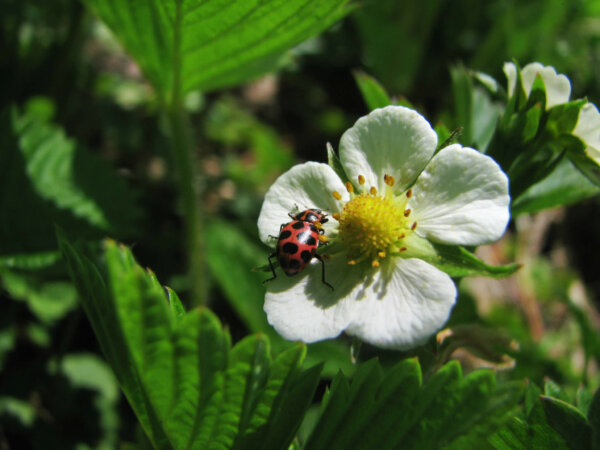
The name “Beetle of Our Lady” originated when the tiny spotted bug was dedicated to the Virgin Mary. The beetle’s spots representing Mary’s joys and sorrows, the bold red wings her cloak. It is believed that the brighter the red of the wings, the better one’s good fortune.
However, since there are more than 500 different species of ladybugs living in the United States and Canada, and greater than 5000 species worldwide, any ladybug is considered lucky: a good omen when it comes a-calling.
Killing a ladybug is said to bring sickness, sorrow, and misfortune. That’s why, over the centuries, cultures around the world have come to cherish the ladybug. Not only do they bring good luck, but ladybugs also have ravenous appetites: happily consuming large volumes of plant-eating pests such as aphids, mites, mealybugs, whiteflies, and leafhoppers.
References
- Why Ladybugs Smell Bad, Chemical and Engineering News
- Ladybugs, Missouri Department of Conservation
- Welcome, The Lost Ladybug Project
- Ladybugs of Pinnacles National Park, National Park Service



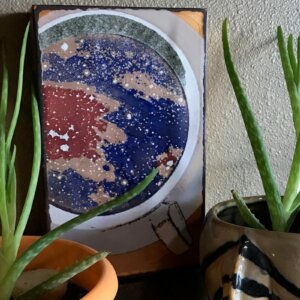




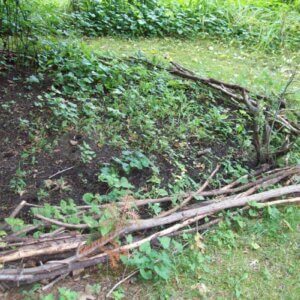

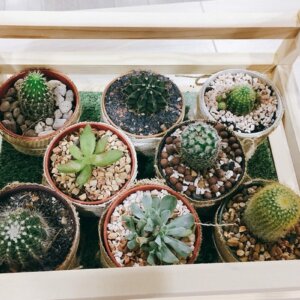













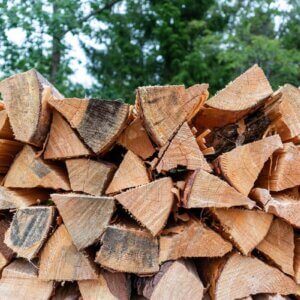















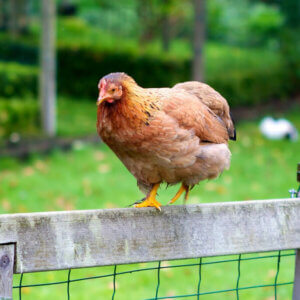

Leave a Reply